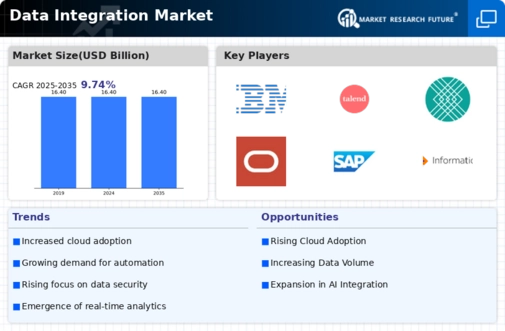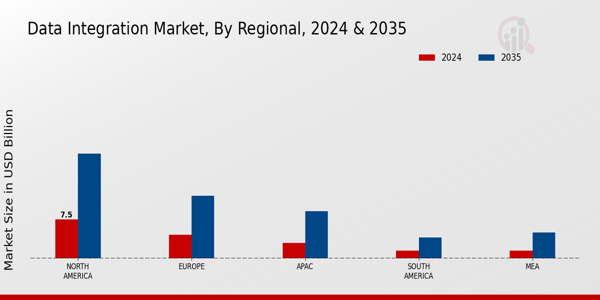Market Trends and Projections
Adoption of Cloud-Based Solutions
The shift towards cloud computing is a pivotal driver in the Global Data Integration Market Industry. Organizations are increasingly migrating their data and applications to cloud environments, necessitating robust data integration solutions that can bridge on-premises and cloud-based systems. This transition not only enhances scalability but also reduces infrastructure costs. As businesses seek to leverage the flexibility of cloud platforms, the demand for effective data integration tools is expected to rise. By 2035, the market is anticipated to maintain its valuation at 16.4 USD Billion, indicating a stable yet evolving landscape where cloud integration remains a critical focus for enterprises.
Emergence of Advanced Analytics and AI
The integration of advanced analytics and artificial intelligence into data integration processes is reshaping the Global Data Integration Market Industry. Organizations are increasingly leveraging AI-driven tools to enhance data quality, automate integration tasks, and derive actionable insights from vast datasets. This trend is particularly pronounced in sectors such as retail and manufacturing, where data-driven strategies can lead to significant competitive advantages. As businesses recognize the value of integrating AI capabilities into their data workflows, the market is poised for growth. The anticipated compound annual growth rate of 0.0% from 2025 to 2035 suggests a stabilization in market dynamics, with a focus on innovation and efficiency.
Regulatory Compliance and Data Governance
Regulatory compliance and data governance are paramount concerns for organizations operating in the Global Data Integration Market Industry. With increasing scrutiny from regulatory bodies, businesses must ensure that their data integration practices adhere to legal standards and industry regulations. This necessity drives the adoption of integration solutions that incorporate compliance features, enabling organizations to manage data securely and transparently. Industries such as finance and healthcare are particularly affected, as they face stringent regulations regarding data handling. Consequently, the market is likely to see sustained growth as companies invest in solutions that not only integrate data but also facilitate compliance with evolving regulatory frameworks.
Rising Demand for Real-Time Data Processing
The Global Data Integration Market Industry experiences a notable surge in demand for real-time data processing solutions. Organizations increasingly recognize the necessity of timely insights to drive decision-making and enhance operational efficiency. This trend is particularly evident in sectors such as finance and healthcare, where data-driven decisions can significantly impact outcomes. As a result, the market is projected to reach 16.4 USD Billion in 2024, reflecting the growing emphasis on integrating real-time data capabilities into existing systems. Companies are investing in advanced integration tools that facilitate seamless data flow, thereby fostering agility and responsiveness in an ever-evolving business landscape.
Growing Importance of Data-Driven Decision Making
The Global Data Integration Market Industry is significantly influenced by the growing importance of data-driven decision making across various sectors. Organizations are increasingly relying on integrated data systems to gather insights that inform strategic initiatives. This trend is particularly evident in industries such as marketing and logistics, where timely access to integrated data can enhance customer experiences and optimize operations. As businesses prioritize data-driven strategies, the demand for effective data integration solutions is expected to rise. This shift underscores the need for tools that facilitate seamless data access and analysis, ultimately driving growth in the market.
























